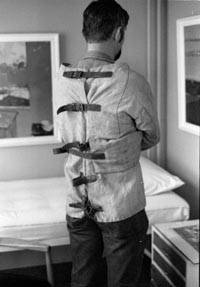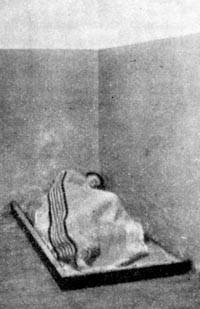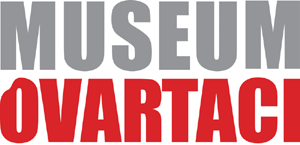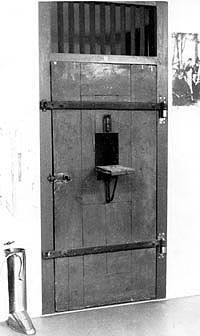First Class |
9 % = 265 patients |
Second Class |
13 % = 384 patients |
Third Class |
78 % = 2.299 patients |
As well as being divided into class and gender, the patients were also divided according to the severity of their disease. In addition there was a special unit for uncontrollable patients of all classes.
Selmer was actually of the opinion that patients from the educated higher classes were more refined and therefore more vulnerable, but he had to acknowledge that the harsh living conditions amongst the lowest classes (smallholders, servants, etc) contributed to a certain degree to the onset of insanity especially amongst women, who were highly represented in the statistics on patients.
Methods of physical treatment and means of coercion 1852-1877

A museum employee
demonstrates a straitjacket.
In 1852 there was no medical treatment available. The most frequently used treatment, for the most violent of the patients, were calming powders and placement in holding cells. Patients were considered healed when, to some extent, they were able to resume their former way of life and personal contacts, and possibly were able to resume their work In the first year after the opening of the hospital readmissions only amounted to 15-17% of the total amount of admissions.
The treatments used were prolonged baths and opium. From 1857 strychnine and bed rest were introduced also as treatments.
Examples of means of coercion were the hand lock, the chair of compulsion, bed strapping, the straitjacket, gloves and foot straps. These were to be used as little as possible.
In the 1870s attempts were made to completely eliminate the use of restraint.
Results of the treatment
Selmer kept thorough statistics on different issues at the hospital. One of those from 1879 shows the results of the treatments they used. The survey was done on all patients in the period from1852 to 1977 and shows the number of patients who were cured or in recovery:
|
Men
(1476)
|
Women
(1472)
|
Both genders
(2948)
|
|
Cured |
29,33 % |
31,52 % |
30,43 % |
|
In recovery |
14,84 % |
18,34 % |
16,59 % |
|
All in all |
44,17 % |
49,86 % |
47,02 % |
H. Selmer: „Sindssygeanstalten ved Aarhus 1852-77“, 1879.
According to Harald Selmer patients were never fully cured, there was always a risk of relapse. Even if the patient did not suffer a relapse, they were forever marked by the disease.
Isolation of patients in cells

A photo from the beginning
of 1900 showing the inside
of a holding cell.
The psychiatrist Hjalmer Helweg’s view on isolation in cells:
"Loneliness worked after a while as an irritant. Agitations and hallucinations intensified and the patient developed vices and became extremely filthy in their behaviour. An alarming by-product of this treatment was a condition known as “cell patient”This condition is described as follows “Patients who are totally undisciplined and almost bestial in their behaviour which manifests itself in a sad and disgusting sight.... a not uncommon result of the treatment at our small local asylums”.
Overcrowding
In the hospital`s first 20 years of existence occupancy was steadily increasing. Shortly after the opening of the asylum, the average occupancy was 60 patients per day. In 1868 the occupancy had reached 400 patients per day, representing a rise of more than 700%. In 1882 it was shown that Jutland Asylum had been able to admit 2/3 of the patients who applied for admittance.
In the hospital’s 100 year jubilee.......just before the breakthrough of psychoactive drugs.......professor Erik Strömgren found that the hospital which was built for 468 patients, now accomodated 810 patients (the prescribed number was 730)
The following year psychiatry policy led to a massive reduction in the number of beds at the major hospitals.



